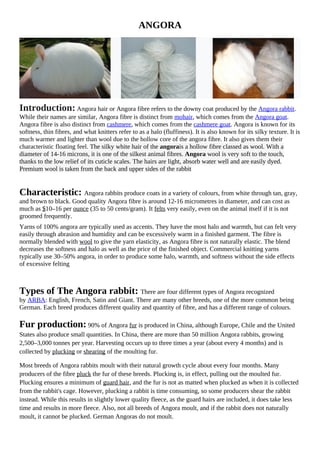
Angora
- 1. ANGORA Introduction: Angora hair or Angora fibre refers to the downy coat produced by the Angora rabbit. While their names are similar, Angora fibre is distinct from mohair, which comes from the Angora goat. Angora fibre is also distinct from cashmere, which comes from the cashmere goat. Angora is known for its softness, thin fibres, and what knitters refer to as a halo (fluffiness). It is also known for its silky texture. It is much warmer and lighter than wool due to the hollow core of the angora fibre. It also gives them their characteristic floating feel. The silky white hair of the angorais a hollow fibre classed as wool. With a diameter of 14-16 microns, it is one of the silkest animal fibres. Angora wool is very soft to the touch, thanks to the low relief of its cuticle scales. The hairs are light, absorb water well and are easily dyed. Premium wool is taken from the back and upper sides of the rabbit Characteristic: Angora rabbits produce coats in a variety of colours, from white through tan, gray, and brown to black. Good quality Angora fibre is around 12-16 micrometres in diameter, and can cost as much as $10–16 per ounce (35 to 50 cents/gram). It felts very easily, even on the animal itself if it is not groomed frequently. Yarns of 100% angora are typically used as accents. They have the most halo and warmth, but can felt very easily through abrasion and humidity and can be excessively warm in a finished garment. The fibre is normally blended with wool to give the yarn elasticity, as Angora fibre is not naturally elastic. The blend decreases the softness and halo as well as the price of the finished object. Commercial knitting yarns typically use 30–50% angora, in order to produce some halo, warmth, and softness without the side effects of excessive felting Types of The Angora rabbit: There are four different types of Angora recognized by ARBA: English, French, Satin and Giant. There are many other breeds, one of the more common being German. Each breed produces different quality and quantity of fibre, and has a different range of colours. Fur production: 90% of Angora fur is produced in China, although Europe, Chile and the United States also produce small quantities. In China, there are more than 50 million Angora rabbits, growing 2,500–3,000 tonnes per year. Harvesting occurs up to three times a year (about every 4 months) and is collected by plucking or shearing of the moulting fur. Most breeds of Angora rabbits moult with their natural growth cycle about every four months. Many producers of the fibre pluck the fur of these breeds. Plucking is, in effect, pulling out the moulted fur. Plucking ensures a minimum of guard hair, and the fur is not as matted when plucked as when it is collected from the rabbit's cage. However, plucking a rabbit is time consuming, so some producers shear the rabbit instead. While this results in slightly lower quality fleece, as the guard hairs are included, it does take less time and results in more fleece. Also, not all breeds of Angora moult, and if the rabbit does not naturally moult, it cannot be plucked. German Angoras do not moult.
- 2. The rabbits must be groomed at least once or twice a week to prevent the fur from matting and felting. There is also a danger a rabbit will ingest its own moulted fur; unlike a cat, a rabbit cannot easily be rid of the build up. Quality of wool: The premium first quality wool is taken from the back and upper sides of the rabbit. This is usually the longest and cleanest fibre on the rabbit. There should not be hay or vegetable matter in the fibre. Second quality is from the neck and lower sides, and may have some vegetable matter. Third quality is the buttocks and legs and any other areas that easily felt and are of shorter length. Fourth quality is totally unsalvageable, and consists of the larger felted bits or stained fibre. Third and fourth quality are perfect for cutting up for birds to use in lining their nests. With daily brushing, felting of the fibre can be avoided, increasing the usable portion of fibre. Uses of angora: Mud River Momist Hypermart Angora wool is commonly used in apparel such as sweaters and suitings, knitting yarn, and felting. Light but warm, angora wool is used mainly in knitted clothes, such as pullovers, scarves, socks and gloves, producing a moderate "fluffing" effect. Angora fabric is ideal for thermal clothing and for people suffering from arthritis and wool allergies. Garments made of 100% angora wool are considered too warm and the fibres are too fine to provide density. It is therefore usually blended with other fibres, such as wool (right) to improve its processing performance, elasticity and wearability. French angora products usually contain up to 20% sheep's wool
- 3. Physical properties: Angora fiber has a low density of about 1.15 g/cm3 to 1.18 g/cm3 compared to 1.33 g/cm3 for wool and 1.50 g/cm3 for cotton. This gives the Angora garments a feeling of being very light but warm. The moisture regain of angora rabbit hair fibers ranges from 12.6 to 13.3% at the standard atmospheric condition of 21ºC and 65% relative humidity Physical Structure: Chemical Structure:
